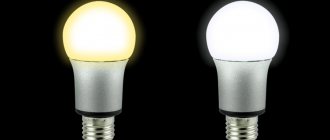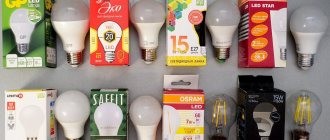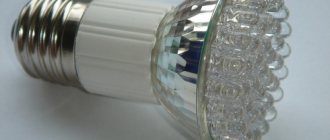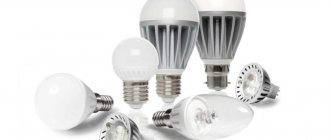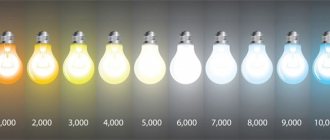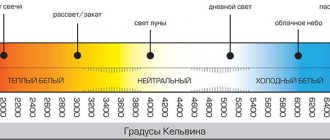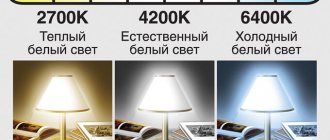The color temperature of LED lamps is one of the main values that characterizes lighting technology. It must be taken into account both when designing a room and when choosing car lamps. Color temperature is a broad concept that includes such characteristics as spectral properties, emission color, color rendering index, etc.
Physical interpretation of color temperature
The temperature of light was described by physicist Max Planck. These treatises presented the laws of energy distribution. As a result, the concept of color temperature appeared. Kelvins were taken as the unit of measure. Based on the formula, this coefficient is equal to the temperature of an absolute black body, which emits light on a measurable scale of colors.
The measurement of this temperature in fluorescent lamps occurs by comparing them with an absolute black body. This is a solid physical body that absorbs electromagnetic radiation incident on it at various temperatures at all latitudes. When the coefficient changes, the radiation parameters also change. Thus, neutral light is located in the middle of the Kelvin scale.
Bodies with different chemical compositions and physical properties, when heated to the required temperature, produce different radiations. In this regard, the term “correlated color temperature” is used. It is equal to the temperature of the shade of an absolute black body, which is identical in color to the light source in question. The composition of the radiation and the physical temperature are different.
Unit of measurement CG
The temperature of lamp light is measured in Kelvin. The unit of measurement characterizes the brightness of the radiation and the length of the wave background in the optical gap.
Features of the thermodynamic temperature unit (kelvin):
- one of the seven leading SI units, introduced in 1848;
- in Russian sources it is designated by the letter K, in international sources the letter K is used;
- to determine the Boltzmann constant, use the expression: 1.380649· 10−23 J/K;
- until code 2022, the coefficient was equal to 1/273.16 of the corresponding temperature (+0.01C) of the triple point of water;
- the scale starts from absolute zero (0 K);
- The name of the unit is given in honor of the title of Lord Kelvin of Largs, which was awarded to William Thomson, a physicist from England.
Previously, kelvin was called the degree Kelvin, denoted by the symbol °K, and was used to determine temperature on an absolute scale. Since 1967, this name has not been used.
Color Temperature Correlation
As the temperature increases, incandescence occurs. If the lamp is in a hot state, the colors on the color temperature scale begin to change alternately. Simple incandescent lamps have a color temperature of 2700 K, while their luminosity and degrees are located in the warm range of the spectrum. The temperature of LED lamps does not indicate the level of their heating: at 2700 K, the lamp heats up to +80°C.
The color rendering index CRI (Ra), also called the color rendering coefficient, is a value that characterizes the degree to which the natural color of an object matches its apparent color when illuminated by a given light source. The need to introduce this parameter is due to the fact that 2 different types of lamps can have the same color temperature, while transmitting shades differently.
Types of household LEDs: design differences
Lamps for the home are classified according to two main criteria: LED type and design.
Based on the first feature, there are three types of diodes:
- SMD – single LEDs;
- COB – matrix of illuminators;
- Filament – diode filament.
SMD. Single LEDs are suitable for board surface mounting. Their feature is directed light emission with a scattering angle of 100-130°. Priority use: spotlights and LED strips.
Structurally, an SMD illuminator is a crystal on a heat-dissipating layer made of copper or aluminum. There are varieties with and without a diverging lens
SMD diodes are durable, as their design ensures good heat dissipation, preventing the device elements from overheating even during continuous operation.
COB. The abbreviation is interpreted as Chip on Bord, translated as a chip on a board. LEDs are a housing of different configurations with SMD crystals integrated into it.
Designations in the photo: 1 – SMD 5050 module, 2 – COB matrix for 36 chips. The luminous flux of COB diodes is significantly higher than single SMDs
Lamps with “matrix” LEDs are not suitable for narrowly focused lighting, but they are also not able to cover the entire surrounding space - their light dispersion angle is less than 180°.
Filament. The innovative LED is designed using the COB principle, but here many mini-crystals are placed on one elongated cylindrical substrate.
Features of Filament LED lamps: a light spectrum that is comfortable for the eyes, the presence of a transparent bulb, and the absence of a cooling radiator. Scattering angle – 360°
Based on their design, diode lamps for household use can be divided into three groups:
- standard models with matte or transparent bulb;
- “corn” with SMD or COD LEDs.
Standard. Traditional lamps available in different shapes: classic, candle, pear, elongated ball, ellipsoid, etc. The type of bulb depends on the LED used. Matte housing is typical for models with SMD or COD crystals, and transparent glass is typical for Filament lamps.
"Corn". Initially, all lighting equipment of this type was manufactured without a bulb. Open SMD diodes were placed on the cylindrical tube, which eliminated the risk of overheating. Later, single LEDs began to be replaced by more powerful COB matrices.
Both options have the following advantages:
- the absence of a bulb increases the brightness of the glow by 25-40%;
- comprehensive coverage;
- maintainability;
- do not need a radiator, which reduces the cost.
The main disadvantage is the danger of contact with open live contacts.
The photo shows: 1 – “corn” with large SMD diodes, 2 – COB LEDs, 3 – small light bulb with bulb
The last option is the least successful. The glass case hides the contacts but blocks heat from escaping. Such a defect leads to rapid burnout of the lamp.
Color perception
Each individual's color perception has its own characteristics. The perception of color is the effect of refraction of light waves received by the optic nerve and processed by the brain's visual center. Each person has their own perception of shades. The older a person gets, the more his color perception becomes distorted. The mental characteristics of an individual also affect his color perception.
The perception of a particular color can be distorted by solar radiation. The warmth of light is also characterized by individual perception and depends on the characteristics of the body and the state of the person at the time of perception.
What parameters are used for technical standardization of light?
All provisions for lighting are in SNiP 05/23/95. There are several criteria, in the list they are listed in order of preference from the most significant:
- Illumination is measured in lumens.
- Color temperature, in Kelvin.
- Color rendering index.
- Ripple factor.
- Maximum permissible brightness.
- Uniformity of lighting.
- Specific power.
Finding the right color temperature is easy. To do this, you do not need to carry out calculations; you can take ready-made data that is suitable for a particular room.
Light colors
It is not difficult to identify a cold object from which no radiation is emitted. The main parameters of light reflection from such an object are indicators such as wavelength and frequency. Another situation occurs with a heated body emitting light. The warmth of light will directly depend on the type of radiation. This can be seen in the example of a tungsten filament in a simple incandescent lamp. The sequence of actions is as follows:
- The light turns on and electricity flows to the terminals.
- There is a gradual decrease in the level of resistance.
- A black body emits red light.
According to accepted standards, there are 3 types of light colors:
- warm white light;
- neutral (natural daytime);
- cool white light.
Review of popular brands of LED products
The ranking of the most popular LED products is headed by light bulbs from Philips and Osram. European manufacturers strictly control the quality of their products. Of course, this approach affects the cost, but given the durability, their price is quite justified. The operating parameters of German lamps correspond to the declared characteristics.
A worthy and more affordable alternative is the products of Bioledex (Germany), FKK (Japan), Nichia (Japan).
The companies have a reputation as reliable manufacturers and have been setting a high bar for the quality of diode lamps for several years now.
Among transnational and domestic projects, the products of the following companies received a worthy assessment:
- Newera (Russia/China) is a trademark of the SVeto-Led brand on the diode technology market for about 10 years, the main advantage is the price/quality balance;
- Ecola (Russia/China) – has a developed retail sales network;
- Gauss (Russia) – the company actively implements the latest technologies, experiments with design and controls quality;
- ASD (Russia) – the level and safety of products are confirmed by the “Russian Nanotechnological Products” mark;
- Uniel (Russia) – a variety of LED lamp series, the main advantages of the products: no flicker, high color rendering index, reasonable price, stylish design; warranty – 2 years.
Separately, it is necessary to mention Chinese-made diode lamps. You definitely shouldn’t buy products from nameless manufacturers. Bulbs from non-name manufacturers do not meet safety standards and declared characteristics. At best, the soffit will shine a little and stop working; at worst, it will harm others.
There are also certified Chinese LED lamps on the market. Products from the following companies received good reviews: Brawex, Selecta, Camelion and Estares
Testing products of popular brands. Advantages and disadvantages of lamps produced by Philips, Canyon and Osram:
Replacing old incandescent light bulbs with technically advanced LED lighting has many positive aspects. In order for LEDs to realize their maximum efficiency and fully recoup the money spent, you should wisely approach the issue of their choice - evaluate a number of parameters and check their performance.
Color temperature and shades
The beginning of the visible range of ray emission reaches a level of 1200 K. In this case, the glow has a reddish tint. With further heating, a change in color begins to occur. At 2000 K, red changes to orange, and then turns to yellow, reaching a level of 3000 K. For tungsten spirals, the highest mark is 3500 K.
LED lamps can heat up to 5500 K and higher. At 5500 K they emit bright white light, at 6000 K they emit bluish light, and at 18000 K they emit purple light.
Temperature affects the perception of color. The coefficients of different color schemes vary significantly.
The Kelvin table, or color temperature table, shows the gradation of colors and shades and gives a clear description of their application.
| Color temperature | Color | Description |
| 2700 K | Warm white, red and white | Predominant in simple incandescent lamps. Brings warmth and comfort to the interior. |
| 3000 K | Warm white, yellowish white | Inherent in most halogen lamps. It has a cooler shade than the previous color. |
| 3500 K | White | Characteristic illumination for fluorescent tubes of different widths. |
| 4000 K | Cold white | Most often used in high-tech style. |
| 5000-6000 K | Natural daytime | Simulates daylight. Used in winter gardens and terrariums. |
| 6500 K | Cold daytime | Widely used in photography and cinema. |
LED lightening
LED lamp is one of the most popular types of lighting devices.
The color temperature of incandescent LED lamps is represented by the following shades:
- warm white (Warm White) - up to 3300 K;
- natural white (Natural White) - up to 5000 K;
- cold white (Cold White or Cool White) - more than 5000 K.
The temperature characteristics of diodes are a determining factor when choosing the area of their use. They are used for street lighting, billboard illumination and automotive lighting equipment.
The advantages of cold light include contrast, due to which it is widely used in lighting darkened areas. Such LED lamps can distribute light over long distances, which is why they are often used in road lighting.
LEDs, which emit a warm glow, are mainly used to illuminate small areas. The luminous flux of warm and neutral tones creates the desired effect in cloudy and rainy weather. The presence of precipitation affects the emission of cold light, while warm light does not undergo any significant distortion in rainy or snowy weather.
The peculiarity of the warm glow of LED lamps is that they allow you to clearly see both the illuminated object and the surrounding area. Thanks to this specificity, warm colors are effectively used for underwater lighting.
The color rendition of LED lamps has its own characteristics: cold shades of light incorrectly convey the colors of surrounding things. Such light creates harshness and brightness, which negatively affects vision. The warm color of the glow has a more beneficial effect on the eyes.
Cold light LED lamps: scope of application
The “specialization” of cold light lamps is illumination of industrial and other work areas, medical offices, illumination of display cases with jewelry. Fixtures that create a cool glow should be used with caution due to the weakening of red and yellow tones. Thus, red acquires violet “notes”, orange turns brown, and yellow becomes greenish. In addition, light sources with a temperature of more than 5000 K can create a tense and unsettling atmosphere, especially in a small space.
The full range of LED lamps is presented in the catalog.
